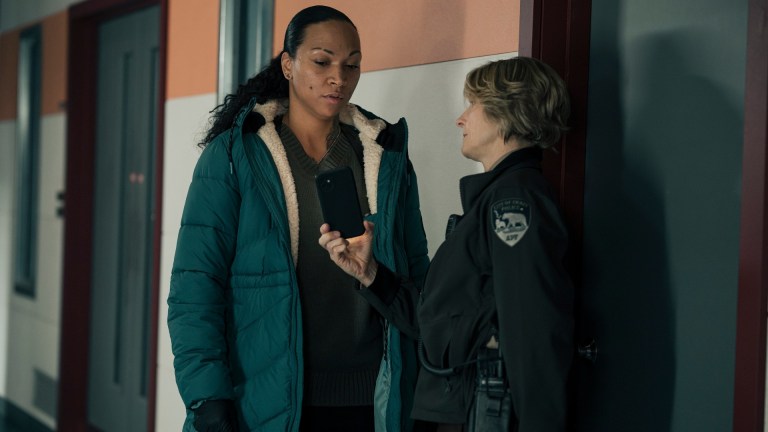What Makes Night Country a True Detective Story
True Detective: Night Country showrunner Issa López and star Jodie Foster reveal the icy inspirations behind season 4.

Through its first three seasons, HBO crime anthology True Detective liked to flirt with the occult. From Rust Cohle’s (Matthew McConaughey) otherworldly hallucinations in season 1 to the mystic hills of the Ozarks in season 3, the series frequently left the door open for realities beyond our own. Time is a flat circle, after all.
It’s only fitting then that True Detective season 4, subtitled True Detective: Night Country, has similarly cosmic origins. The season, which stars Jodie Foster and Kali Reis as detectives investigating mysterious disappearances during the perpetual night of winter in Northwest Alaska, came together in a kismet fashion. In a pre-season conversation with journalists, Night Country writer, director, and producer Issa López discussed how she was already working on a very True Detective-esque script before she got an actual True Detective call from HBO.
“I had put a bunch of ideas on a pot to cook and one of them was a modern Western on the ice. It was the idea of a murder mystery with a couple of characters. That preceded the call from HBO asking ‘what would you do with True Detective?'” López says. “I don’t think that happened by chance, you know. I think there was a reason I was already thinking in these terms.”
Up until now, True Detective has been the singular vision of its creator Nic Pizzolatto, who wrote or co-wrote every episode of the first three seasons. When Pizzolatto signed a deal with FX Productions in 2020, however, it left the future of HBO’s hit up in the air. Enter López: a visionary Mexican filmmaker best known for her 2017 feature Tigers Are Not Afraid.
Retrofitting her original idea into the True Detective format ended up feeling even more natural than López expected.
“It was amazing how the elements of True Detective came together. You remember that scene in Minority Report where Tom Cruise starts putting the case together [on the futuristic screen]? It was like that: ‘Oh this True Detective rule, tradition, or DNA mixes with this idea.’ It just came together beautifully.”
Despite being the only edition of the show with a subtitle so far, Night Country indeed feels distinctly True Detective. Buy why exactly? What makes a True Detective story a True Detective story? Thankfully, López and star Jodie Foster expounded upon the elements necessary to create crime drama with a macabre twist. A season of True Detective needs…
Two Mismatched Detectives
The concept of two detectives investigating a crime was always baked into López’s initial, non-True Detective idea and it’s not hard to see why. From Holmes and Watson onward, the mystery genre has always made great use of mismatched sleuth partnerships and so too has True Detective. Season 1 of the show enjoyed the iconic Rust Cohle (Matthew McConaughey)/Marty Hart (Woody Harrelson) pairing, season 2 put forth Ray Velcoro (Colin Farrell) and Ani Bezzerides (Rachel McAdams), and season 3 responded with Wayne Hayes (Mahershala Ali) and Roland West (Stephen Dorff).
Night Country‘s duo is the obsessive, ingenious Liz Danvers (Jodie Foster) and the focused, bruising Evangeline Navarro (Kali Reis). Danvers is languishing in the small town of Ennis, Alaska after a decorated career in Anchorage, while Navarro quite literally has Ennis in her blood due to her Iñupiaq ancestry. Though the two women come from extremely different backgrounds, they seem to make a smoother team than your usual True Detective union.
“There are moments where they are on totally parallel journeys and moments where they’re on totally opposite journeys,” Foster says. “Navarro’s fate is tangled up with the idea of justice. Danvers, on the other hand ,has embraced the role of moral relativity. Both of those destinies really help each other in the end.”
Danvers and Navarro may be more agreeable with each other because their inspiration comes not from the hardboiled detective stories that Pizzolatto preferred, but from López’s appreciation of reality TV.
“I did watch endless hours of Alaska Troopers which is a fabulous reality show,” she says. “In remote areas [of Alaska], a single trooper is supposed to police a really vast territory. It can become a complicated endeavor. There are a lot of delicate issues that happen in these communities. They have to do with addiction, isolation, and certain depression that younger generations are facing.”
And that brings us to the next element that a True Detective story needs …
A Unique American Setting
A True Detective season is nothing without its setting. Few other shows excel at finding the spooky geographic corners of North America quite like this one. Season 1 took place in the cursed swamps of the Bayou, while season 2 turned the Los Angeles highway system into something alien and unsettling, and season 3 presented the Ozark Mountains as a craggy haunted house.
Night Country, obviously, takes place in “Night Country” – deep in rural Alaska during the winter months of the calendar where darkness can last for weeks and ice makes every step a logistical nightmare. That creates a sense of urgency for Danvers and Navarro to solve the case while also lending the proceedings a snowy ethereal tone.
“There’s something very beautiful and kind of mystical and eerie about this place where you don’t see the sun for three months,” Foster says. “I think it really served the True Detective model of ‘let’s locate the place first and then the Americana and weirdness of that place will inform the psychological space of the characters.’
Initially unable to make the trip to Alaska due to the pandemic, López became captivated with the region remotely, trawling YouTube for videos of Alaskans going about their daily lives and listening to local radio stations. Once travel was possible, López and production made their way to the 49th state to research small towns like Nome, which came to serve as the inspiration for their fictional Ennis’s sleepy downtown.
Setting the series in Alaska also meant being able to find fresh perspectives for True Detective to explore. López collaborated with Illuminative, a social justice organization led by Native women to increase the visibility of indigenous stories, and assembled an advisory council of Iñupiaq women.
“In those towns, the ethnic makeup is at least 70% native. Mostly Iñupiaq,” López says. “You cannot, in good conscience, set a story in this universe if 70% of what you’re saying doesn’t deal with this. It’s not about background. It’s not about interesting things to look at. You have to embrace it, understand it, and accept it.”
With a unique location and a couple of bickering detectives in place, there’s only one more thing a season of True Detective needs …
A Touch of the Occult
If it’s not at least a little weird, then it’s not True Detective. Even though the first three seasons of the show eventually revealed themselves to be grounded in reality, the possibility that something truly supernatural was afoot lent them real dramatic momentum.
Night Country, bless it, has plenty of weirdness to offer as well. The season’s first scene is something straight out of John Carpenter’s The Thing, and throughout its six episodes the veil between worlds feels thinner than ever. For López and director of photography Florian Hoffmeister (who just won an Oscar for Tár), dallying with the supernatural offered distinct aesthetic advantages.
“We both had this vision of, instead of fighting the dark, letting the dark come in. Even in interior shots, we have these really profound blacks. The whole ethos of the show is that we can only see part of reality.”
As its name suggests, True Detective: Night Country does let the dark come in. It also presents a modest update to a reliable formula. How does that update compare to the first three, un-subtitled, editions of the show? You’ll have to watch to find out!
True Detective: Night Country premieres Sunday at 9 p.m. ET on HBO. New episodes air Sundays, culminating with the finale on Feb. 24, 2024.
